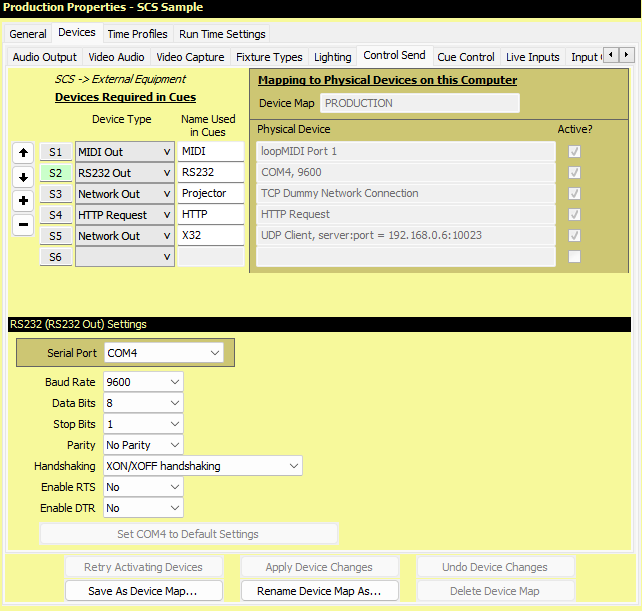
Production Properties - Control Send Devices - RS232
RS232 Control Send Devices are only available with SCS Professional and higher license levels.
Overview
In SCS you may set up Control Send cues to send commands to external equipment such as sound mixers or lighting boards where Control Send cues can be used to select pre-programmed scenes, snapshots, etc. They can also be used to send control messages to other software, which may be running on a separate computer. See Control Send Cues for details. The layout of the lower part of the screen depends on the Device Type of the currently-selected device. The example below shows the layout for an RS232 serial device.

Properties and Controls
|
Devices Required in Cues Here you need to identify each device you want to use in Control Send cues. You select the Device Type and give the Device a Name that will be used in your Control Send cues. |
Mapping to Physical Devices on this Computer All your Device mappings are held in a Device Map. This is the same Device Map used for Audio Output Devices, so the name of that Device Map is displayed but is not editable here. The Physical Devices chosen are for this Device Map on this computer. Where there are no suitable device type available then you can select a dummy. This enables you to set up, for example, RS232 Control Send cues on a computer that does not have an RS232 port available. |
Device Number (S1, S2, etc): If this number is displayed with a colored background (eg see S2 in the above screenshot) this indicates this device is the 'current' device for the Sidebar Controls to the left, and for the 'Settings' panel displayed below the device list. To make a different device the 'current' device, click on any field in the line for the required device, or on the Device Number itself.
Sidebar Controls: Controls are available to enable you to easily change the order of the devices as explained for Audio Output Devices.
Device Type: This drop-down list contains the Control Send device types supported by your license level. This Help page describes the properties etc for 'RS232 Out' devices.
Name Used in Cues: Enter the name you want to use for the device in your Control Send cues. Note that SCS provides a default name based on the Device Type but you can change this if you wish.
|
Computer-Specific Fields Physical Device: The physical device assigned to this Name Used in Cues. The Physical Device is a display-only field based on the 'Settings' provided in the lower part of the screen. Active?: This display-only checkbox will be checked if SCS has successfully initialized this device, or will be blank if the initialization failed. If you have devices that have not been initialized successfully, click Retry Activating Devices at the bottom of this tab. Serial Port: Select the required Serial Port from the drop-down list. The entries available in the list will depend on the installed devices and possibly whether or not they are connected and switched on. SCS looks for serial ports in the range COM1 - COM32. At the end of the list you will see 'Dummy Serial Port'. Selecting the Dummy entry enables you to set up Control Send cues for this RS232 device even if you have no real serial port available. |
Other RS232 Out Settings
Baud Rate: Select the required baud rate from the drop down list. This must match the corresponding setting on the device that is to receive the RS232 messages. The default is 9600.
Data Bits: Select the required number of data bits from the drop down list. This must match the corresponding setting on the device that is to receive the RS232 messages. The default is 8 data bits.
Stop Bits: Select the required number of stop bits from the drop down list. This must match the corresponding setting on the device that is to receive the RS232 messages. The default is 1 stop bit.
Parity: Select the required parity setting from the drop down list. This must match the corresponding setting on the device that is to receive the RS232 messages. The default is 'No Parity'.
Handshaking: Select the required handshaking protocol from the drop down list. This must match the corresponding setting on the device that is to receive the RS232 messages. The default is XON/XOFF. (For AMX Netlinx Control Systems, set this to 'No Handshaking'.)
Enable RTS: Select the required 'Request To Send' setting from the drop down list. This must match the corresponding setting on the device that is to receive the RS232 messages. The default is No (RTS not enabled).
Enable DTR: Select the required 'Data Terminal Ready' setting from the drop down list. This must match the corresponding setting on the device that is to receive the RS232 messages. The default is No (DTR not enabled).
Set <Serial Port> to Default Settings: Clicking this button will set all the above to their default values
Device Map Buttons
The buttons at the foot of the tab apply to all device types as explained for Audio Output Devices.
< Previous Topic (Control Send Devices - MIDI) | Next Topic (Control Send Devices - Network) >